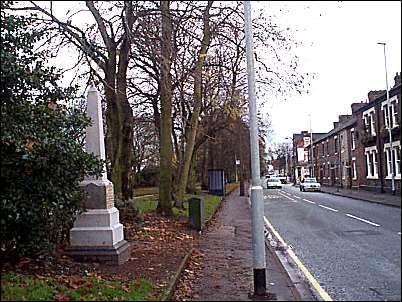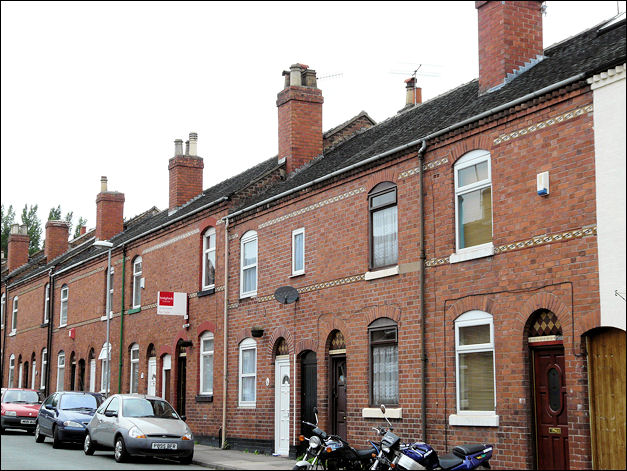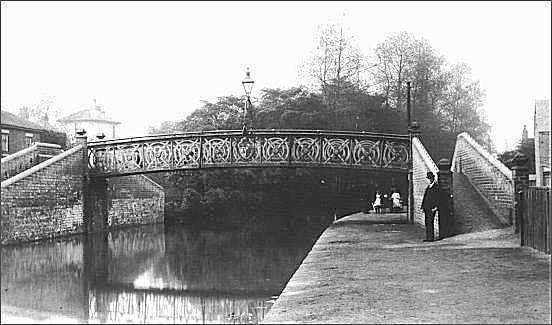|
Newcastle-under-Lyme Canal
"canal hero who gave his
life to save a drowning girl"
  
click the
"contents" button to get back to the main index & map
next:
Newcastle-under-Lyme
Canal Pt 3
previous:
Newcastle-under-Lyme
Canal Pt 1
|
Historian Fred Hughes
writes....

Trow memorial obelisk ,
London Road, Stoke
 on the monument
on the monument
The
actions of 21 year-old tram conductor Timothy Trow on April 13th
1894 were certainly above and beyond the call of duty. It was around 4pm
that Friday afternoon when the young Stoke man leapt from his footplate
and vaulted over a line of iron railings into the murky Newcastle Canal as
it flowed along London Road. Four-year old Jane Ridgway had been playing
on the towpath when she tumbled in and, thanks to the brave conductor
who’d heard her screams, the child was saved. But non-swimmer Timothy lost
his life, sucked to the bottom of the foul water.
“This
was an amazing act of bravery,” historian Steve Birks asserts. “And it
was lucky for the girl that the tram had stopped. In those times the
engine was powered by steam and it would have been extremely noisy. His
funeral apparently was an extraordinary affair and the community was so
moved that it collected money to erect a public memorial. The granite
gold-inscribed obelisk, standing today opposite James Street in London
Road, is a tribute to a true Potteries hero.”
Our
journey following the bed of the ill-fated Newcastle canal has brought us
to this point. It’s a spot that former paramedic Frank Deakes, age 73,
knows well for he was born and brought up in nearby Water Street, so-named
because of the waterway’s proximity.
“The
monument has always been here as far as my memory serves me,” says Frank.
“In fact when I was a boy there was still some water in it and we used to
catch tiddlers here.”
|

Sherburne Road, Stoke
This is
the West End district of Stoke and it’s full of surprises. Like, for
instance, the story of Gold Coin. Sherburne Road faces the Trow memorial.
Now, there’s nothing out of the ordinary about this row of excellent 19th
century terrace houses except that each has two lines of gold-glazed
bricks running above and below the upper windows. And on each brick the
words ‘Gold Coin’ is scrolled. Frank is as baffled as I am. But local
window-cleaner Geoff Smith offers a strange explanation.
“My
father who had the window round before me told me that the man who built
the houses was a familiar face at the Racecourse at Sideway,” says Geoff.
“Apparently one day he won a lot of money which he invested in building
these houses. Being pleased with his success he incorporated the line of
gold bricks all the way up the street telling the tenants that he’d put a
gold sovereign behind one of the bricks of each house for luck. But he
didn’t say which brick. Amazingly after all these years very few bricks
have been disturbed. And the name of the winning horse was – as you’ve
already guessed – Gold Coin.”

|
Before
the Michelin came in 1927 the racecourse played a prominent part in the
districts known as Boothen, West End and Sideway. All this was in Frank’s
backyard.
“My
grandfather had a shop in London Road Just opposite Corporation Street.
Coming towards Oakhill there was a fancy bridge near Nursery Street and
something like a turntable bridge at the top of All Saints Road. This
was where the new Michelin factory, built by Peter Lindt who I think was
a Dutch engineer, began. My father was one of the first to work on the
site and the Michelin built the row of houses in Water Street. They’re
still there and so is number 35 where we lived,” recalls Frank. “When I
came on the scene Michelin was massive in size and was a major city
employer. It occupied all the land lying between Campbell Road and
London Road and it continued to grow into the 1960’s. There was a high
wall all around it with three main entrances called Chester Gate, Bolton
Gate and Oakhill Gate. The canal travelled along Michelin’s boundary
between this wall and London Road. In fact some of the wall is still
standing by the Oakhill Gate along a greenway.”
As you
approach Oakhill past the Trow memorial, this pleasant pathway has
continued to extend even since the dramatic scaling down of Michelin’s
factory. It has now become a continuous tree-lined thoroughfare that could
easily be mistaken for some Parisian boulevard.

The footbridge over the
Newcastle Canal was near to Nursery Street
This view looks towards Stoke - near to the place where Timothy Trow
drowned
“This
layout began as long ago as 1953,” says Steve. “It was opened in the
year of the Queen’s coronation and is named Coronation Gardens in
tribute to it. Before this both the road and canal bed ran side by side
up Oakhill to the Cottage pub where they parted company.”
One of
Steve’s maps clearly shows this division before Michelin arrived. It also
shows Oakhill as a small cluster of houses surrounded by fields. The canal
travelled along the down slope into these fields to the outskirts of Trent
Vale and Hanford before turning sharp right into the Lyme Valley towards
Newcastle.
“Kensington Road Oakhill follows the canal line continuing past Rookery
Lane,” says Steve. “Up to now it’s been relatively easy to follow the lost
canal. Then it suddenly and spectacularly vanishes beneath the
continuously changing road complex. But never mind, we shall pick it up
again when we find more evidence of it along Riverside Road over the A34.”
 more on the
Newcastle-under-Lyme canal
more on the
Newcastle-under-Lyme canal
|
![]()
![]()
![]()